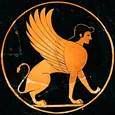
To make a long story short, the former theory which is accepted by most people in the fragrance business implies that odoriferous molecules are perceived by our nose through their shape variation, different shapes attaching to one another and producing different effects. Dr.Turin has proposed that it is the vibrational difference of various molecules that accounts for the difference in perception and not their shape. The odour receptors detect the frequency of those vibrations of odour molecules in the infrared range by electron tunnelling.
Of course the modern counterpart to the theory of Shape was the discovery of odorant receptor molecules by Linda B. Buck and Richard Axel. The two scientists were awarded the Nobel Prize in 2004.
The battle carries on still, however, as of yet there is not a complete answer to how olfactory perception is shaped.
But how did the theory of Shape come into being? Perfume Shrine delves in antiquity and elected to present the ancient reference to an allusion to such a notion to our readers. Of course the nature of smell had been debated by Parmenides, Democritus and Xenophanes prior to this, but it is in Lucretius that it takes...shall we say, shape.
Titus Lucretius Carus(96-55BC) proposed that pleasant smells -as well as sensations acting as a pleasant stimulus in general- are composed of smooth particles, while the reverse phenomenon -unpleasant smells and sensations- is due to the hooked nature of the particles that form the material. This was of course intergrated into the research into why the universe is made of pleasant and unpleasant things to man.
Lucretius says:
"Thou traverse through, thou wilt discover thus
That in their frame the seeds of many things
They hide, and divers shapes of seeds contain.
Further, thou markest much, to which are given
Along together colour and flavour and smell,
Among which, chief, are most burnt offerings.
. . . . . .
Thus must they be of divers shapes composed"
"For every shape, which ever charms the senses, has not been brought to being without some smoothness in the first beginnings; but, on the other hand, every shape which is is harsh and offensive has not been formed without some roughness of substance".
{from De rerum natura, book II}
Perhaps this ancient theory of tactility was what gave to rise the concept of smell being perceived through the shape of the atoms of the materials smelled. Or this is my theory in any case...
References: Bailey, C. ed. De Rerum Natura. 3 volumes with commentary. Oxford, 1947.
Buck, Linda and Richard Axel. (1991). A Novel Multigene Family May Encode Odorant Receptors: A Molecular Basis for Odor Recognition. Cell 65:175-183.

.jpg)




